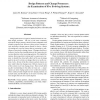Free Online Productivity Tools
i2Speak
i2Symbol
i2OCR
iTex2Img
iWeb2Print
iWeb2Shot
i2Type
iPdf2Split
iPdf2Merge
i2Bopomofo
i2Arabic
i2Style
i2Image
i2PDF
iLatex2Rtf
Sci2ools
METRICS
2003
IEEE
2003
IEEE
Design Patterns and Change Proneness: An Examination of Five Evolving Systems
Design patterns are recognized, named solutions to common design problems. The use of the most commonly referenced design patterns should promote adaptable and reusable program code. When a system evolves, changes to code involving a design pattern should, in theory, consist of creating new concrete classes that are extensions or subclasses of previously existing classes. Changes should not, in theory, involve direct modifications to the classes in prior versions that play roles in a design patterns. We studied five systems, three proprietary systems and two open source systems, to identify the observable effects of the use of design patterns in early versions on changes that occur as the systems evolve. In four of the five systems, pattern classes are more rather than less change prone. Pattern classes in one of the systems were less change prone. These results held up after normalizing for the effect of class size — larger classes are more change prone in two of the five syste...
| Added | 05 Jul 2010 |
| Updated | 05 Jul 2010 |
| Type | Conference |
| Year | 2003 |
| Where | METRICS |
| Authors | James M. Bieman, Greg Straw, Huxia Wang, P. Willard Munger, Roger T. Alexander |
Comments (0)

